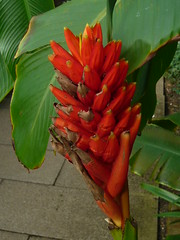Gardening Epithets and Plant Names
The purpose   botanical names of plants is to provide some information about a particular plant that distinguishes it from other plants. Starting with the species or type of plant then an adjective applied to the plant, the specific epithet, which is often helpful in describing the plant.
This second word can often tell us the colour of the flowers, the height of the plant, whether the leaves are long and thin or short and fat, whether the plant is sticky or prickly, where it comes or who discovered it. (There is only so much space for information so a bit of detective work may be needed).
Below are three lists of the Latin specific epithets often used in gardening or naming of plants. Nearly all trees and shrubs are feminine usually ending in –a, ( whilst male names end –us but mean the same). You can add to these lists as your knowledge grows.
Latin Epithets for Colour

Musa Coccinea.
alba – white
aurea – golden, yellow
chrysantha or flava,  lutea  -yellow and sulphurea – yellow
aurantiaca – orange and citronella – lemon
coccinea, rubra or punica – red and sanguinea – blood-red
purpurea – deep pink or rosea – rose pink
phoenicea – purple and violacea – violet
viridis – green
pallidia – cream,
incana – grey or glaucus – greyish- blueish
argentea – silvery,
azurea or caerulea – blue
nigra – black
Dictionary of Botanical Epithets contains a great deal more information, derivations, stems and meanings.
Latinized Epithets Location or Origination

Crocus Corsicus
alpicola or alpestris – from mountains
arenaria – from sandy places
alpina – from the alps
australis – from the south  not necessarily Australia
chinensis – from China
japonica – from Japan
saxatilis – of rocks
sibirica – from Siberia
sinense – from China
sylvestris – of woods
Latinized Epithets of Plant Characteristics

Hypericum perforatum
angustifolia – narrow-leaved  Â
acaulis – stemless
arboricola – living on trees
armata – prickly  and glutinosa – sticky
arvensis or campestris – of the field
autumnalis – of autumn and vernalis – of spring
barbata – bearded, hairy
bulbifera – bearing bulbs
campanulata – campanulate, like a bell
compacta – compact or gigantea – giant
decidua – deciduous
densiflora – dense-flowered
digitata or palmate – leaves like a hand, with five lobes
flore plena – with double flowers
florida – floriferous
foetida – with an unpleasant smell
fruticosa – shrubby
glabra – smooth
grandiflora – large-flowered
hirsuta – hairy or hispida – bristly
humilis – short
inodora – unscented
lanata – woolly
lanceolata – lance-shaped (leaves)
latifolia – wide-leaved
longiflora – with long flowers longifolia – with long leaves
macrocarpa – large-fruited
macrophylla – with large leaves
macrorrhiza – with large roots
maculata – spotted
maritima – maritime, near the sea
micrantha – small flowered
microphylla – with small leaves
nana – small
odorata – perfumed
officinalis – with herbal uses
pauciflora – few-flowered
pendula – hanging
perennis or redivida – perennial
pinnata – with pinnate leaves
praecox – early, of spring
procumbens – creeping
prostrata – prostrate
pumila – small
quercifolia -oak leaved
rotundifolia – round-leaved
sativa – cultivated
scandens – climbing
semperviva – perennial
spinosa spiny
stellata starry
tenuifolia – with thin, narrow leaves
trifoliata – trifoliate, with three-lobed leaves
umbellata – unbellate, with flowers in an umbel
viscosa – sticky
vitifolia – with leaves like a vine
vulgaris – common.